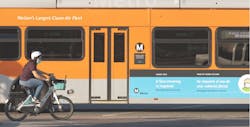L.A. Metro recovery task force releases draft final report and recommendations to improve county’s quality of life post-pandemic
The Los Angeles County Metropolitan Transportation Authority (L.A. Metro) Recovery Task Force, which was created in April to respond to the COVID-19 pandemic, has released a draft of its final report that includes recommended actions the agency can take in the wake of the public health crises.
The report includes research on how the pandemic has impacted Metro and Los Angeles County, updates on progress toward the Task Force’s initial recommendations and a new set of final recommendations with implementation plans. The report also acknowledges that L.A. Metro still faces significant challenges and uncertainties with the number of COVID-19 cases surging in the region.
The task force believes that L.A. Metro can come back stronger and that its recommendations could help prevent a return to conditions prior to the pandemic — that is, horrible traffic, dangerous streets, dirty air that also causes climate change and long-standing inequities that make it more difficult for low-income people and people of color to get around and access the things they need to survive and thrive.
The task force has tracked data on key pandemic impacts:
- People of color have been disproportionately impacted by the pandemic in terms of illness, death and loss of jobs and income. Working moms have borne the brunt of school closures.
- L.A. Metro transit ridership fell sharply, partly rebounded and is currently about 50 percent of pre-pandemic levels. Remaining transit riders are predominantly essential workers: low-income people of color with little access to private vehicles.
- The annual budget for the 2020-21 fiscal year fell by approximately 16 percent due to lower local sales tax revenues.
- Vehicle traffic is returning faster than transit ridership, and many regions have seen increased car purchases.
Task force recommendations were developed as a direct response to these impacts. The recommendations are unmistakably ambitious and were designed to result in meaningful change that improves the quality of life for all L.A. County residents, says L.A. Metro.
The 17 final recommendations include proposals to improve mobility and to pay for these improvements. Many expand upon actions that L.A. Metro and its stakeholders are already pursuing. These recommendations also draw upon global best practices that are in line with L.A. Metro’s mission of providing world class transportation.
- L.A. Metro is seeking public input on these 17 recommendations. The comment period closes Jan. 8, 2021.
- Improve HOV lanes so that they move faster than general lanes, expand express lanes and run express buses on select HOV and express lanes.
- Accelerate networks of complete streets that prioritize buses and are safe and appealing for all users — including pedestrians and bicyclists.
- Fully-integrate transit in L.A. County. To put it another way, imagine a world in which there’s one great transit map, a standard fare (or maybe no fare) across the county’s transit systems and there are easy transfers between all transit systems.
- Offer incentives to reduce car ownership in L.A. County. The number of registered vehicles in the county is more than eight million and has grown steadily for decades. The county is running out of room to accommodate more vehicles and expanding roads is expensive, often widely opposed by residents and impacts the environment and quality of life.
- Improve station amenities with more retail and restrooms at rail stations; have more shade, comfort and better arrival information at bus stops.
- Improve public engagement and strengthen rider voices so that L.A. Metro can quickly target and fix common issues.
- Gather more comprehensive data on equity and travel patterns to better understand where people are going and when. This kind of travel data helped shape the recent NextGen Plan and helps L.A. Metro figure out when and where to bolster service. More demographic info can help L.A. Metro advance equity.
- Share data and information more openly and effectively. This is just good government and could lead to better products for riders (such as the official app, Transit) and helps taxpayers see how the agency is doing and encourages the public to suggest improvements.
- Accelerate joint development and transit-oriented communities because living near transit provides more residents with more options besides driving.
- Expand the region’s broadband infrastructure so all residents have access to information, telecommuting and education via the internet.
- Create more green jobs and green infrastructure to improve the region’s environment and bolster the local economy for the long term.
- Reimagine Metro’s Destination Discounts to incentivize taking transit to key businesses and cultural offerings.
- Study how L.A. Metro can reduce capital construction costs to expand the system faster and free funds for other purposes.
- Build L.A. Metro staff capacity; the thinking here is that the more agency staff can do, the less the agency will have to rely on contracting for services.
- Use the Measure M and R sales taxes to help cities respond to the pandemic.
- Expand revenue opportunities to help fund, for example, improvements such as better bus stops and more affordable housing near transit.
- Identify funding for incentives to reduce car ownership.


